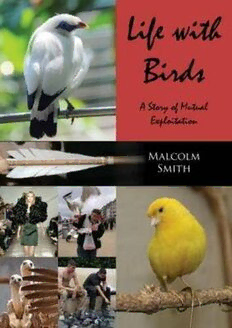Table Of ContentLife with Birds
Life with Birds
A Story of Mutual
Exploitation
Malcolm Smith
Whittles Publishing
Published by
Whittles Publishing Ltd.,
Dunbeath,
Caithness, KW6 6EG,
Scotland, UK
www.whittlespublishing.com
© 2011 Malcolm Smith
All rights reserved.
No part of this publication may be reproduced,
stored in a retrieval system, or transmitted,
in any form or by any means, electronic,
mechanical, recording or otherwise
without prior permission of the publishers.
Every effort has been made to trace copyright holders and to obtain
their permission for the use of copyright material. The publisher
would be grateful if notified of any amendments that should be
incorporated in reprints or future editions of this book.
ISBN 978-184995-028-2
Printed by
For my soulmate, my support and inspiration. And for my growing
family in the hope that they might be interested.
Contents
Preface ...................................................................................................... ix
Acknowledgements ............................................................................ xiii
1 A free lunch ........................................................................................ 1
2 A sporting chance ......................................................................... 17
3 Domestic bliss ............................................................................... 33
4 A softer life ...................................................................................... 47
5 Off to war ....................................................................................... 59
6 Helping each other ...................................................................... 70
7 City slickers .................................................................................. 81
8 Getting into a paddy .............................................................. 95
9 A load of garbage ....................................................................... 112
10 The art of using birds ............................................................ 124
11 The beauty stakes ...................................................................... 139
12 All myth and superstition ................................................ 154
Further reading .................................................................................. 171
Author’s biography ............................................................................ 172
Preface
An early morning jog in a city park. A lunchtime break from the office. A drive through rush hour
traffic. A leisurely weekend walk along your local river or through a favourite wood perhaps.
You may not notice them – or you might care not to – but, wherever you are, birds will be there
too. Maybe just a city pigeon picking up a few crumbs on a pavement. Some sparrows chirping on a
nearby building. A robin beside you as you work in your garden. The noisy, grating calls of a crow or
seagull on a rooftop. Or the cadenzas of early morning birdsong from nearby trees.
From the earliest days of human existence, birds have tagged along with us. They still do. They
raid our crops for some easy eats. They use nooks and crannies in our buildings to nest. Sometimes
they even help clear up our garbage. And they are a reminder, even in the most built-up environments
we create, that a natural world still exists.
We have long exploited birds. Think how often we eat them, chicken especially; turkey at
Christmas or at Thanksgiving. Eggs, mostly from chickens – boiled, scrambled, easy-over fried or as
an ingredient of our cakes and many other foods – are a dietary mainstay. And we are snug on many
a winter’s night because duvets full of feathers keep us warm while we sleep.
Birds have long inspired our art, from early Neolithic drawings to Van Gogh’s foreboding
depiction of rooks against a stormy sky painted just hours before his untimely suicide. They inspire
much of our music, too, both classical and pop. They feature on a surprising number of postage
stamps and who isn’t familiar with a local called ‘The Swan’ or some other pub named after a bird.
Wherever we have chosen to live, from isolated farms to the bustle of city centres, birds have
joined us there. And many of them have adapted amazingly well to our changing lifestyles.
A surprising number have set up home in our largest cities. House Crows squawk in the noisy
sprawl of Mumbai. Cormorants fly up and down the River Thames through the centre of London.
American Robins feed on the White House lawns. Smart-looking Tree Sparrows – countryside
birds across Europe – ply the pavements of Bangkok alongside arguably the most vehicle-congested
roads in the world. Turkey Vultures nest on the high rises in Mexico City. And in dusty Timbuktu
on the edge of the mighty Sahara, sand-coloured Barn Owls perch at night on identically coloured
buildings ready to pounce on a passing rodent.
But do we know why certain birds, not others, have adapted to city life? And is it possible to
predict which ones might yet do so? The simple answer is no. With hindsight it might have been
possible to predict that Peregrines would set up home in cities. After all, our high-rise buildings
provide them with ‘cliffs’ to nest on and plenty of prey such as city pigeons to kill. But ravens haven’t
become city slickers even though they, too, nest mainly on cliffs and eat a broad diet including
almost anything they can scavenge.
It might just be that some birds are innately more adaptable than others. We know a lot about
the behaviour and the ecology of very many species but perhaps still not enough to understand the
intimate detail of their requirements and the degree to which they can adapt to new circumstances
and new opportunities.
ix

